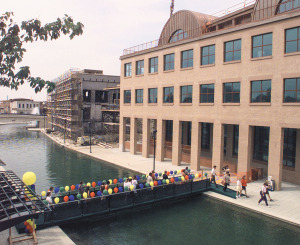
The inside story: How Indianapolis landed the NCAA headquarters
A two-year courtship that pitted Indianapolis against some of the largest U.S. cities culminated in the May 1997 announcement that Indianapolis had snagged the headquarters.

A two-year courtship that pitted Indianapolis against some of the largest U.S. cities culminated in the May 1997 announcement that Indianapolis had snagged the headquarters.
Manufacturers and trucking groups are supportive of the legislation, but opponents, including law enforcement agencies, have raised concerns about possible damage to state infrastructure and safety on the roads.

Gov. Eric Holcomb is not having much luck getting what he wants from the General Assembly this year, even though both chambers are overwhelmingly dominated by his Republican Party.
What if we advanced our clocks this weekend and never had to turn them back? The idea is gaining some traction after a bipartisan group of U.S. senators this week reintroduced a bill that would keep daylight saving time year-round.

During the occasionally tense hearing on House Bill 1123, a slew of officials from Gov. Eric Holcomb’s administration tried to convince lawmakers that the governor’s ability to make quick decisions has been key to the state’s response to the COVID-19 pandemic.
The president signed the aid package into law Thursday without a comprehensive plan in place to distribute all of the funds, which will be a core focus of the administration in coming weeks.
The funding is part of an overall $1.9 trillion bill that could send as much as $5.87 billion to the state, including roughly $237 million to Indianapolis and another $187 million to Marion County.
At least 65 public school boards have passed formal resolutions against the proposed legislation through a campaign organized by the Indiana School Boards Association.

The funding would instead go to courses in areas that are typically higher paying, such as nursing, biomedical science and welding. But critics say eliminating popular programs would narrow students’ options.
Indiana would join 32 other states, including bordering states like Illinois, Ohio and Kentucky, in having a music production incentive program if the bill passes.
The measure, which union leaders and labor allies have presented as a cure for decades of working-class wage stagnation, was approved on a mostly party-line 225-206 vote.

House Bill 1006 includes provisions for mandatory de-escalation training, misdemeanor penalties for officers who turn off body cameras with intent to conceal, and bans on chokeholds in certain circumstances.
Indiana lawmakers are considering legislation that would freeze property tax assessments for four years when a property owner wins an appeal.
Indiana Attorney General Todd Rokita, who drew criticism last month over his decision to retain employment with a health care benefits business while serving in his elected position, says he has “concluded” the private-sector job.
Indiana Gov. Eric Holcomb sat wearing a face mask in the front passenger seat of an SUV while getting the shot in his right arm of the single-dose Johnson & Johnson vaccine being given during the drive-through clinic.
Democratic leaders made more than a dozen late changes in their package, reflecting their need to cement unanimous support from all Democratic senators—plus Vice President Kamala Harris’ tie-breaking vote—to succeed in the 50-50 chamber.
The Indiana Department of Natural Resources on Thursday announced nearly $30 million in trail-development grants to 18 statewide recipients, with more than a third of that money going to projects in Marion, Hamilton, Boone, Hendricks and Hancock counties.

Young, 48, had widely been expected to seek another term and made it official on Twitter on Tuesday morning, saying “more work remains” to be done.
Banks have less than a year before the Fed has indicated it will stop allowing them to enter into new contracts pegged to LIBOR, a bedrock of the financial system being phased out by global policy makers.
During the presidential campaign, Joe Biden pledged to deploy $2 trillion on infrastructure and clean energy, but the White House has not ruled out an even higher price tag.